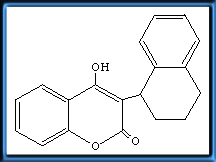Coumatetralyl is a first generation anticoagulant of the warfarin type. Symptoms of overexposure relate to failure of the blood clotting mechanism and include bleeding gums and failure of blood clotting after skin wounds. After one exposure the toxicity of coumatetralyl is relatively low, however if overexposure continues over several days the product becomes more toxic. That is, the product must be constantly present in the blood for more than 1 to 2 days in order to be hi ghly toxic. A single exposure, even though relatively large, may not produce toxic sypmtoms as the compound is quite rapidly metabolised. Chronic: animal studies show no evidence of carcinogenic or teratogenic effects.Chemical Name (IUPAC): 4-hydroxy-3-(1,2,3,4-tetrahydro-1-naphthyl)coumarin
Chemical Formula: C19H16O3
Chemical Structure:
LD50/LC50: LD50 Oral (ingestion) - rat 16.5 mg/kg LD50 Dermal (skin contact) - rat 25-30 mg/kg These data refer to the active constituent. The toxicity of the product is greater after repeated exposure than in a single dose. Animal tests have shown coumatetralyl not to have any carcinogenicor teratogenic potential.
If poisoning occurs contact a doctor or Poisons Information Centre. Vitamin K1 (phytomenadione) is antidotal. If swallowed, and if more than 15 minutes from a hospital, induce vomiting, providing the patient is concious, preferably using a correct emetic. If on skin, wash material off the skin with soap and water. If in the eye, hold eye open and flood with water for at least 15 minutes and see a doctor.
